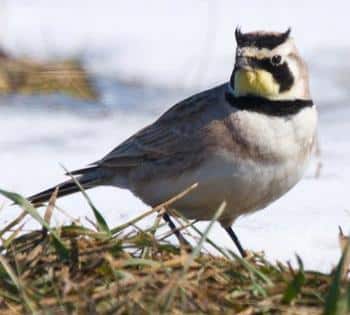Horned Larks Coming Through

Horned lark
Photo credit: Ben Wilson
by Clay Christensen
Contributing Writer
My wife and I saw our first horned larks in Wabasha County, in southeastern Minnesota, in March 1988. As best we can recall, we were spending the weekend at a bed and breakfast and took an afternoon to drive around the county looking for birds. Neither of us remembers where we stayed, but we both remember the horned larks. What gorgeous birds!
At about seven inches in length, the horned lark looks like a smaller, slimmer version of a meadowlark. It sports that same V-necked sweater look. The male actually does have feathery “horns” on its head, above and behind the eyes, but they aren’t always displayed. The “horns” are joined by a black “sweatband” across the forehead.
The male horned lark also has a dark mask that droops down the cheek as well as that matching dark V-necked breast band. The chin and neck are yellow with a hint of yellow in the eyebrow. The back is brown, the underside is white. The female is similarly marked, but in very muted colors.
Some horned larks spend the winter in southern Minnesota, sometimes as far north as the Twin Cities. The horned larks that migrate south begin returning north into Minnesota in early February through late March. My buddies and I saw some at Lake Elmo Regional Park on March 14 this year.
I’ve found them most regularly along quiet country roads as the snow is just beginning to disappear from the fields. They’re usually pecking along the edges of a gravel road in small groups. They’re often fairly tame and just crouch when you approach. But as you get closer, they lift up, skim over the field, then drop suddenly and melt into the ground color.
They’ve been known to sit still for as long as five minutes. If you watch very carefully, especially if you scan slowly with binoculars, you will see them begin to run and stop, run and stop, along the furrows, like robins would.
Horned larks have a very horizontal posture, running with the head down. They look more like a mouse than a bird. Their song is a very high-pitched tinkley sound, often hard to hear.
For its courtship display, the male sings while it ascends to about 800 feet, then circles and sings for up to several minutes before folding its wings and diving headfirst toward the ground. It flares out at the last second, puffs up its chest, droops its wings and raises its horns to strut before the female.
The horned larks passing through Minnesota are usually heading for far northern Canada, to the tundra, where the Arctic wind and long cold winters keep willows and birch trees no more than a few inches high. They prefer wide open spaces with little or scrubby vegetation.
When they’re on their breeding territory, their diet includes moths, butterflies, caterpillars, beetles, wasps, spiders, grasshoppers and large ants as well as the fruits and seeds of the bog bilberry.
But, since they migrate northward so early in the year, they have to be very resourceful at finding things to eat along the way. They really like winter corn fields where they pry cutworms out of the base of the corn plants. They also favor sod farms, athletic fields, the trimmed edges of airport runways…any place with very short grass.
While there’s still snow on the ground, they frequent feed lots and farmyards, looking for grain spills, and they especially like plowed fields that have been freshly spread with manure.
So, this spring when I drive down Roselawn Avenue and notice that pungent odor from the St. Paul Campus farm fields, I’ll slow down and look for horned larks creeping among the furrows. Depending on the wind direction, I may leave the windows rolled up.
Clay Christensen writes The Birdman of Lauderdale column which appears in the St. Anthony Park “Bugle,” where a version of this article first appeared.



